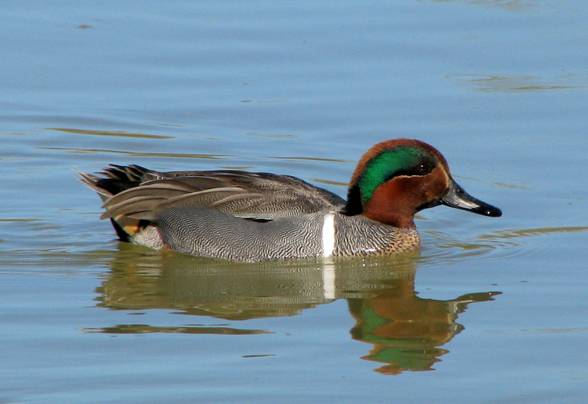|
|||||||||||||||||||||||||||
First documented observation of Common Teal (Anas crecca crecca) in
Pierre Deviche (deviche@asu.edu) Michael Moore (Michael.moore@asu.edu) On the morning of 2 March 2008, Later in the day the bird was found again by other birders including M. C. Moore, L. Hatcher, and J. Burns. The only previous sight report of Common Teal in
Figure 1: Adult male Common Teal, Gilbert Water Ranch Riparian Preserve in Gilbert, Maricopa Co.,
Figure 2. Adult male Common Teal, Gilbert Water Ranch Riparian Preserve in Gilbert, Maricopa Co., The taxonomy of birds in the Anas crecca/carolinensis complex is unsettled (Livezey 1991). Behavioral, morphological, and molecular genetic studies (Johnson and Sorenson 1999, Sangster et al. 2002) suggest that this complex consists of two species: Green-winged Teal (A. carolinensis) and Common Teal (A. crecca). Consistent with this view, most countries outside Given the above taxonomic confusion the question naturally arises: Is Common Teal countable separately from American Green-winged Teal? Most North American birders follow the Female Green-winged and Common Teal, as well as immature males and males in eclipse of these subspecies, are difficult to separate visually (Cramp et al. 1977, Millington 1998, Sibley 2000), but adult males in alternate plumage normally show conspicuous differences as summarized by Gillson (2004; Figures 1-3): - White scapular stripe. The inner web of the lower scapular wing feathers in Common Teal is white. In a bird at rest this web forms a bright horizontal white bar that extends laterally from the shoulder to the tail. In contrast, this inner web in Green-winged Teal is brownish gray, and this subspecies, therefore, never displays a horizontal lateral white stripe. - Vertical white breast bar. Green-winged Teal has a vertical white bar along the side of the breast. This bar is absent in Common Teal. - Pale facial lines. The bill of Common Teal is outlined by bold pale lines that extend to the forehead. This subspecies also shows a pale line under the eye that continues posteriorly to clearly delineate the ventral border of the green ear patch. These lines in Green-winged Teal are thinner and subdued, creating a less strongly patterned head than that of Common Teal. Additional features - head and breast color, body size, and side vermiculations (Cramp et al. 1977, Gillson 2004) - separate Green-winged and Common Teal, but are more subtle than the above characters and, therefore, generally difficult to assess in the field unless birds of the two subspecies are seen concurrently, at close range, and under similar light conditions. Overall, however, based on the above main differences, field observers should have no difficulty separating typical adult male Green-winged and Common Teal in alternate plumage. It is noted that hybrids with intermediate characteristics do occur (Gillson 2004). Hybrids often have both white stripes (usually reduced in size and brightness) but can even have the pattern of an American Green-winged Teal on one side and a Common Teal on the other side. Only adult males showing all the above characteristics and lacking any trace of the vertical breast bar can be safely identified as Common Teal. The Gilbert Water Ranch individual had a conspicuous horizontal white stripe, no trace of a vertical white breast bar, and a strongly marked head pattern (Figures 1 and 2), and thus showed no overt sign of hybrid origin.
Figure 3: Adult male Green-winged Teal, Gilbert Water Ranch Riparian Preserve in Gilbert, Maricopa Co.,
Common Teal are rare but somewhat regular along both the North American Pacific and ACKNOWLEDGMENTS We are indebted to Narca Moore-Craig for constructive suggestions on an early version of the manuscript. LITERATURE CITED American Ornithologists’ Union 1998. Check-list of North American birds. 7th ed. Allen Press, Barnes, S. 2008. Guide to birding the northern Clements, J. F., Diamond, J., White, A.W. and Fitzpatrick, J. W. 2007. The Clements checklist of birds of the world. Cramp, S., Simmons, K. E. L., Ferguson-Lees, I. J., Gillmor, R., Hollom, P. A. D., Hudson, R., Nicholson, E. M., Ogilvie, M. A., Olney, P. J. S., Voous, K. H., and Wattel, J. 1977. Handbook of the Birds of Europe and the Middle East and Edwards, J. L. 1932. European Teal (Nettion crecca) in northern Gillson, G. 2004. Common Teal: Eurasian and American Green-winged Teal and hybrids: an identification challenge. http://thebirdguide.com/identification/Eurasian_Teal/teal_hybrid.htm Hamilton, R. A., Patten, M. A., and Erickson, R. A. 2007. Rare birds of Harris, S. W. and Gerstenberg, R. H. 1970. Common Teal and Tufted Duck in Johnson, K. 1995. Green-winged Teal (Anas crecca). The birds of Johnson, K. P. and Sorenson, M. D. 1999. Phylogeny and biogeography of dabbling ducks (Genus: Anas): A comparison of molecular and morphological evidence. Auk 116: 792-805. Livezey, B. C. 1991. A phylogenetic analysis and classification of recent dabbling ducks (Tribe Anatini) based on comparative morphology. Auk 108: 471–507. Monson, G. and Phillips, A. R. 1981. Annotated Checklist of the Birds of Phillips, A., Marshall, J., and Monson, G. 1964. The Birds of Sangster, G., Knox, A. G., Helbig, A. J., and Parkin, D. T. 2002. Taxonomic recommendations for European birds. Ibis 144: 153–159. Sibley, D. A. 2000. The Sibley Guide to Birds. A.A. Knopf, Inc., Sturts, S. 2008. A Comprehensive List of Review Species Reports in Webster, R. E. 2006. The status of Mottled Duck (Anas fulvigula) in Accepted 16 September 2008 |
|||||||||||||||||||||||||||
|
|||||||||||||||||||||||||||




